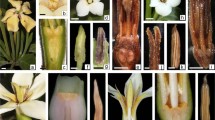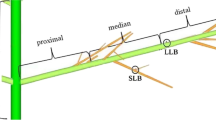Abstract
The evolutionary pathway between hermaphroditism and dioecy draws widespread interests, and androdioecy is rarely achieved as an intermediate state between the two breeding systems. Flower bud differentiations in the pistils of hermaphrodites and the pistillodes of males in androdioecious Osmanthus fragrans L. were investigated by paraffin sectioning to elucidate the evolution to androdioecy. Results showed that the regularity and rhythm in flower bud differentiation between males and hermaphrodites were almost consistent and included six main stages. However, the hermaphrodites always lagged behind the males at each stage. The apical floret in the same inflorescence developed earlier than did the lateral ones in both hermaphrodites and males. The most significant difference between males and hermaphrodites was observed at the carpel differentiation stage. Two carpel primordia appeared inside the stamens of both males and hermaphrodites at the initial stage. These two carpels gradually fused with each other in hermaphrodites and eventually developed into a normal pistil with a stigma, a style, and an ovary. However, a cavity grew conspicuously over time between two carpels as developed in males. The two carpels eventually developed into a pistillode with two independent bracteal tissues. However, from the whole development process, the male retained the developmental residue of the hermaphrodite. Thus, the pistillodes of males could be traced to the pistils of hermaphrodites. This finding shows that males may be derived from hermaphrodites in O. fragrans. On the basis of this finding and previous studies on Oleaceae, androdioecy could be regarded as a transition from hermaphroditism to dioecy in this family.




Similar content being viewed by others
References
Akimoto J, Fukuhara T, Kikuzawa K (1999) Sex ratios and genetic variation in a functionally androdioecious species, Schizopepon bryoniaefolius (Cucurbitaceae). Am J Bot 86:880–886
Bawa KS (1980) Evolution of dioecy in flowering plants. Annu Rev Ecol Syst 11:15–39
Caporali E, Carboni A, Galli MG, Rossi G, Spada A, Longo GPM (1994) Development of male and female flowers in Asparagus officinalis. search for point of transition from hermaphroditic to unisexual developmental pathway. Sex Plant Reprod 7:239–249
Caporali E, Spada A, Marziani G, Failla O, Scienza A (2003) The arrest of development of abortive reproductive organs in the unisexual flower of Vitis vinifera ssp. silvestris. Sex Plant Reprod 15:291–300
Charlesworth D (1984) Androdioecy and the evolution of dioecy. Biol J Linn Soc 23:333–348
Charlesworth D (1999) Theories of the evolution of dioecy. In: Geber MA, Dawson TE, Delph LE (eds) Gender and sexual dimorphism in flowering plants. Springer, New York, pp 33–60
Charlesworth B, Charlesworth D (1978a) A model for the evolution of dioecy and gynodioecy. American Naturalist 112:975–997
Charlesworth D, Charlesworth B (1978b) Population-genetics of partial male-sterility and evolution of monoecy and dioecy. Heredity 41:137–153
Cheng PC, Gryson RI, Walden DB (1983) Organ initiation and the development of unisexual flowers in the tassel and ear of Zea mays. Am J Bot 70:450–462
Daher A, Adam H, Chabrillange N, Collin M, Mohamed N, Tregear JW, Aberlenc-Bertossi F (2010) Cell cycle arrest characterizes the transition from a bisexual floral bud to a unisexual flower in Phoenix dactylifera. Ann Bot 106:255–266
Dellaporta SL, Calderon-Urrea A (1993) Sex determination in flowering Plant. Plant Cell 5:1241–1251
Dellaporta SL, Calderon-Urrea A (1994) The sex determination process in maize. Science 266:1501–1505
Dommée B, Bompar JL, Denelle N (1990) Sexual tetramorphism in Thymelaea hirsuta (Thymelaeaceae): evidence of the pathway from heterodichogamy to dioecy at the infraspecific level. Am J Bot 77:1449–1462
Dorken ME, Friedman J, Barrett SCH (2002) The evolution and maintenance of monoecy and dioecy in Sagittaria latifolia (Alismataceae). Evolution 56:31–41
Farbos I, Oliveira M, Negrutiu I, Mouras A (1997) Sex organ determination and differentiation in the dioecious plant Melandrium album (Silene latifolia): a cytological and histological analysis. Sex Plant Reprod 10:155–167
Franken AA (1970) Sex characteristics and inheritance of sex in asparagus (Asparagus officinalis L.). Euphytica 19:277–287
Gleiser G, Verdu M (2005) Repeated evolution of dioecy from androdioecy in Acer. New Phytol 165:633–640
Grant S, Hunkirchen B, Saedler H (1994) Developmental differences between male and female flowers in the dioecious plant Silene latifolia. Plant J 6:471–480
Hao RM, Zang DK, Xiang QB (2005) Investigation on natural resources of Osmanthus fragrans Lour. at Zhouluocun in Hunan. Acta Horticulturae Sinica 32:926–929
Hao RM, Zhao HB, Wang JH, Zhou LH (2011) Observation and study on breeding system of wild Osmanthus fragrans. J Plant Res Environ 20:17–24
Ishida K, Hiura T (1998) Pollen fertility and flowering phenology in an androdioecious tree, Fraxinus lanuginosa (Oleaceae), in Hokkaido, Japan. Int J Plant Sci 159:941–947
Krahenbuhl M, Yuan YM, Kupfer P (2002) Chromosome and breeding system evolution of the genus Mercurialis (Euphorbiaceae): implications of ITS molecular phylogeny. Plant Syst Evol 234:155–170
Landry CL, Rathcke BJ (2007) Do inbreeding depression and relative male fitness explain the maintenance of androdioecy in White mangrove, Laguncularia racemosa (Combretaceae)? New Phytol 176:891–901
Lepart J, Dommee B (1992) Is Phillyrea angustifolia L. (Oleaceae) an androdioecious species? Biol J Linn Soc 108:375–387
Liston A, Rieseberg LH, Elias TS (1990) Datisca glomerata is functionally androdioecious. Nature 343:641–642
Liu HL, Zong M, Xuan ZC, Lu S, Shen BC, Ding XS, Qiu YX (2007) Morphological differentiation of flower bud of Osmanthus fragrans ‘Zao Yingui’ and ‘Xiaoye Sugui’. Acta Horticulturae Sinica 34:1559–1562
Liu Y, Luo ZL, Wu XQ, Bai XF, Zhang DX (2012) Functional dioecy in Morinda parvifolia (Rubiaceae), a species with stigma-height dimorphism. Plant Syst Evol 298:775–785
Lloyd DG (1974) The genetic contributions of individual males and females in dioecious and gynodioecious angiosperms. Heredity 32:45–51
Lloyd DG (1975) The maintenance of gynodioecy and androdioecy in angiosperms. Genetica 45:325–339
Lloyd DG (1979) Evolution towards dioecy in heterostylous populations. Plant Syst Evol 131:71–80
Lloyd DG (1980) The distributions of gender in four angiosperm species illustrating two evolutionary pathways to dioecy. Evolution 34:123–134
Luo SX, Zhang DX, Renner SS (2007) Duodichogamy and androdioecy in the Chinese Phyllanthaceae Bridelia tomentosa. Am J Bot 94:260–265
Mayer SS, Charlesworth D (1991) Cryptic dioecy in flowering plants. Trends Ecol Evol 6:320–325
Nishide M, Saito K, Kato H, Sugawara T (2009) Functional Androdioecy in Morinda umbellata subsp. boninensis (Rubiaceae), Endemic to the Bonin (Ogasawara) Islands. Acta phytotaxonomica et geobotanica 60:61–70
Pannell JR (1997) Widespread functional androdioecy in Mercurialis annua L. (Euphorbiaceae). Biol J Linn Soc 61:95–116
Pannell JR (1999) Variation in sex ratios and sex allocation in androdioecious Mercurialis annua. J Ecol 85:57–69
Pannell JR (2000) A hypothesis for the evolution of androdioecy: the joint influence of reproductive assurance and local mate competition in a metapopulation. Evol Ecol 14:195–211
Pannell JR (2002) What is functional androdioecy? Funct Ecol 16:862–865
Pendleton RL, Freeman C, McArthur ED, Sanderson SC (2000) Gender specialization in heterodichogamous Grayia brandegei (Chenopodiaceae): evidence for an alternative pathway to dioecy. Am J Bot 87:508–516
Renner SS, Won H (2001) Repeated evolution of dioecy from monoecy in Siparunaceae (Laurales). Syst Biol 50:700–712
Rieseberg LH, Hanson MA, Philbrick CT (1992) Androdioecy is derived from dioecy in Datiscaceae: evidence from restriction site mapping of PCR-amplified chloroplast DNA fragments. Syst Bot 17:324–336
Ross MD (1982) Five evolutionary pathways to subdioecy. American Naturalist 26:1–8
Ross MD, Weir BS (1976) Maintenance of males and females in hermaphrodite populations and the evolution of dioecy. Evolution 30:425–441
Saumitou-Laprade P, Vernet P, Vassiliadis C, Hoareau YV, Magny G, Dommée B, Lepart J (2010) A self-incompatibility system explains high male frequencies in an androdioecious plant. Science 327:1648–1650
Vassiliadis C, Lepart J, Saumitou-Laprade P, Vernet P (2000) Self-incompatibility and male fertilization success in Phillyrea angustifolia (Oleaceae). Int J Plant Sci 161:393–402
Vassiliadis C, Saumitou-Laprade P, Lepart J, Viard F (2002) High male reproductive success of hermaphrodites in the androdioecious Phillyrea angustifolia. Evolution 56:1362–1373
Verdú M, Montilla AI, Pannell JR (2004) Paternal effects on functional gender account for cryptic dioecy in a perennial plant. Proc Royal Soc London B 271:2017–2023
Wallander E (2008) Systematics of Fraxinus (Oleaceae) and evolution of dioecy. Plant Syst Evol 273:25–49
Wallander E, Albert VA (2000) Phylogeny and classification of Oleaceae based on rps16 and trL-F sequence data. Am J Bot 87:1827–1841
Wang CY, Gao LP, Lu DF, Huang YW (2002) A study on morphological differentiation of flower bud of Osmanthus fragrans ‘Houban Jingui’. Acta Horticulturae Sinica 29:52–56
Webb CJ (1999) Empirical studies: evolution and maintenance of dimorphic breeding systems. In: Geber MA, Dawson TE, Delph LE (eds) Gender and sexual dimorphism in flowering plants. Springer, New York, pp 61–95
Wolf DE, Takebayashi N (2004) Pollen limitation and the evolution of androdioecy from dioecy. American Naturalist 163:122–137
Yang XL, Xiang QB (2007) Morphological differentiation of flower bud of Osmanthus fragrans ‘Wanzi Yingui’ and ‘Duo Jingui’. J Nanjing Forestry University (Natural Sciences Edition) 31:105–108
Yang LL, Chen M, Liu FQ, Geng Y, Chen C, Li YQ, Cao ZX, Xu ZH, Bai SN (1999) Study on sepal morphology, metabolize, feature of genetic expression in male flowers of cucumber. Chin Sci Bull 44:2509–2513
Yuan GF, Wang QM (2004) Carpel development in male flowers of cucumber (Cucumis sativus L.). Acta Biologiae Experimentalis Sinica 37:63–66
Zhang L, Simmons MP, Kocyan A, Renner SS (2006) Phylogeny of the Cucurbitales based on DNA sequences of nine loci from three genomes: implications for morphological and sexual system evolution. Mol Phylogenet Evol 39:305–322
Acknowledgments
This work was supported by the National Natural Science Foundation of China (Grant No. 30771761, 31170656 and 31101571), Zhejiang Provincial Natural Science Foundation of China (Grant No. Y3100221 and Y3110357), Young Teacher Innovation Team Item of Zhejiang Agriculture and Forestry University (Grant No. 2010RC01) and Zhejiang Provincial Major Program of New cultivar breeding (Grant No. 2012C12909-9).
Author information
Authors and Affiliations
Corresponding author
Rights and permissions
About this article
Cite this article
Xu, YC., Zhou, LH., Hu, SQ. et al. The differentiation and development of pistils of hermaphrodites and pistillodes of males in androdioecious Osmanthus fragrans L. and implications for the evolution to androdioecy. Plant Syst Evol 300, 843–849 (2014). https://doi.org/10.1007/s00606-013-0923-6
Received:
Accepted:
Published:
Issue Date:
DOI: https://doi.org/10.1007/s00606-013-0923-6




